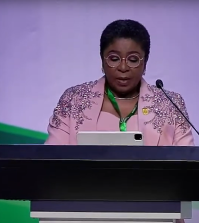The Power of Blockchain

“Blockchain sounds a bit like magic,” says Mark MacDonald.
“It isn’t magic, but if you are interested in addressing foundational business, information management and accountability and transparency challenges, we think it is quickly emerging as the most powerful technology to do that.”
The Global Lead Partner, Public Financial Management, at consultancy EY was addressing a webinar on “The Power of Blockchain” in which he outlined the potential of this exciting technology to resolve a wide range of public finance problems.
Organised by Global Government Forum, the webinar was attended by 275 civil service leaders from around the world and responds to rapidly growing interest in blockchain – a highly secure distributed ledger of linked online records that continuously grows.
EY has emerged as a leading source of expertise in the use of blockchain in the public sector, and MacDonald pointed to an announcement last week that the consultancy had teamed up with Microsoft to launch a solution for the electronic gaming sector.
He noted that this technology is seen as a positive “disruptive” force with a wide range of applications, making it important for PFM managers to understand it – and get on board.
“How quickly is this really, truly, going to take off? It’s anybody’s guess, but our guess is that it will probably move more quickly than we can ever anticipate.
A major issue faced by public servants from the outset is what blockchain can do for them. In a video played to the webinar, EY Global Blockchain Leader Paul Brody set out questions they should ask to help determine its applicability.
Key challenges in public administration are the need to coordinate the activity of multiple parties, ensure trust and information exchange between them, guarantee the creation of tamper-proof records of transactions, safely manage public assets, and ensure transparency.
Brody said: “Blockchains work best as complementary to existing infrastructure systems: blockchain should be the glue that lets siloed systems work with each other.”
Public financial management
Blockchain has potential use in a wide spectrum of government transactions but it is in public financial management that the technology may be uniquely potent.
MacDonald said: “From the PFM perspective we think there is a core foundation in blockchain technology that can potentially help with public budgeting and financial accountability – and, of course, that underpins all of government action.”
Blockchain comes into its own first and foremost where there are “costly and often cumbersome” information exchanges across multiple parties and diverse institutional boundaries, he pointed out.
“Whether I am a central budget authority or whether I am the endgame service delivery agent, everybody should have a greater ability to exchange and manage financial and non-financial conditions for public expenditure.”
In a blockchain world, said MacDonald, public finance managers might be able to model “quite easily and certainly quite effectively” how a fiscal position and set of accounts would actually change under a cash versus accrual perspective.”
He said blockchain becomes particularly valuable when attaching non-financial objectives and conditions to assets, with significant advantages for regulation, service delivery, and internal controls.
While this technology has hitherto demonstrated its potential in the realm of certification –notarising user features to confirm identities, for example – a future area of growth will be the “tokenisation” of assets converted into a digital form.
“We are not dealing with cryptocurrency here,” said MacDonald. “But what we are starting to think about very quickly is putting fiat currency into a digital form that can be tokenized and used in the blockchain context.
“There are many central banks around the world that are thinking about this but as we get into the prospect of things like putting taxation nodes on the blockchain for the payment of VAT, for instance, having a digital form of fiat currency, legal tender, will make such a situation even more powerful.”
Finally, blockchain has significant implications for the conduct – and cost – of auditing.
“We think there is a huge opportunity to greatly reduce the cost of audit-based compliance frameworks as they exist today,” said MacDonald. “The reason is that the requirement for audit in a blockchain essentially disappears.”
Ease of use
While to a novice blockchain technology may appear blindingly complex, MacDonald said a key element of its promise is its ease of application.
Governments are looking for the ability to provide new forms of information management (IM) in public decision-making without having to reconfigure existing systems, and blockchains do not require costly and risky replacements or upgrades to IM or IT systems.
“The blockchain technology itself is, relatively speaking, fairly simple, and it is certainly less cumbersome than perhaps traditional, major IM/IT systems that are fraught with risk from an implementation perspective,” MacDonald said.
“As we are finding very quickly, one of the powers of blockchain is to be able to connect very rapidly to those underlying systems without having to introduce costly, risky changes to them.
“This will improve my ability as a public servant to discharge my public accountability responsibilities, better public reporting, better transparency, but just as importantly it provides me with a better evidence base to make the sorts of decisions that are required for the delivery of public services.”
EY has devised a methodology to employ blockchain technology to extract data from existing underlying ICT systems.
At the same time, implicit in blockchain technology is a high degree of confidentiality and security that further reduce risk in public administration.
The EY blockchain platform
To illustrate potential applications, MacDonald examined the PFM Blockchain platform developed by EY.
While key governmental challenges relate to costly information exchanges and insufficient transparency and accountability across inter-agency interfaces, the blockchain solution “floats” gracefully above these allowing information management in near to real time.
“So, a central budget authority will now be increasingly confident about how the appropriation structure is being accounted for and consumed; a programme ministry or department will have increasing confidence in its ability to demonstrate that policy objectives are being met; and a delivery agent will have increasing confidence that it is meeting performance targets in a financially efficient way.”
MacDonald highlighted the stylised example of an education system to demonstrate how a working blockchain solution would enable any party – from a Treasury board to delivery structures – to benefit from comprehensive information at any stage.
“We can have real-time information at any point of access along that node on the blockchain helping us to answer three questions reliably: what is money being spent on, how is it being spent from a productivity and efficiency perspective, and what outcomes are being achieved?”
It is a testament to the promise of blockchain that according to MacDonald “we are well past the concept stage – we are in fact deep into the proof-of-concept stage.”
This requires everyone with a stake in better public service to recognise “that the world is moving exceptionally quickly”, he noted.
“It is hard to imagine that a government around the world hasn’t already thought about this and significant numbers are moving into pilots – but the full industrialisation of this is going to happen almost exponentially and very, very quickly.”
Please watch a recording of the presentation here:


















This article provides a positive++ spin on blockchain technology. I found that a subsequent Global Government Forum article—Blockchain: alchemy or wizardry?—was more balanced.
Given that Canada’s federal government is still dealing with the Phoenix fiasco after two years, it is not obvious to me that governments (of any country) are ready and capable of implementing blockchain technology.
Private enterprises largely risk their own assets, but governments risk much more.